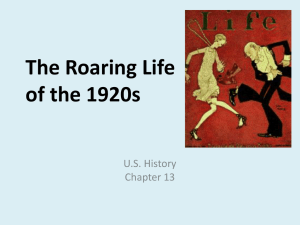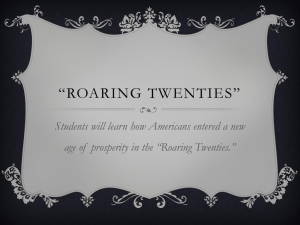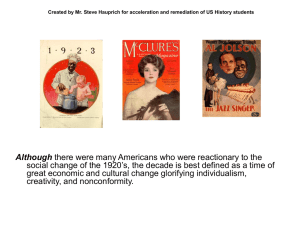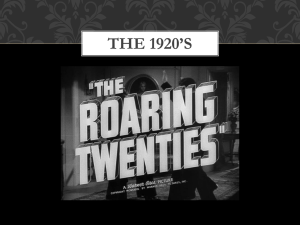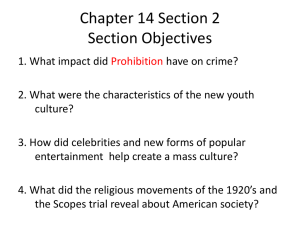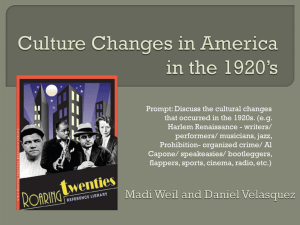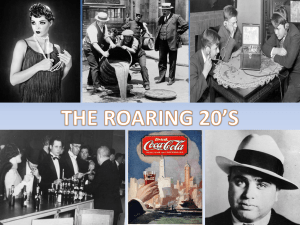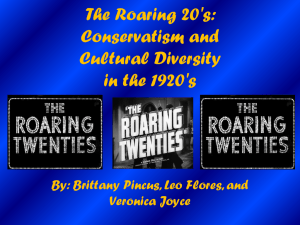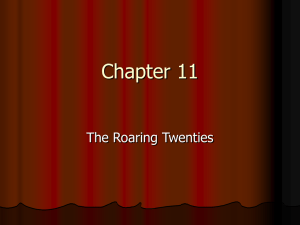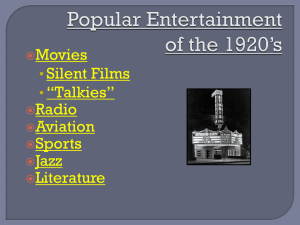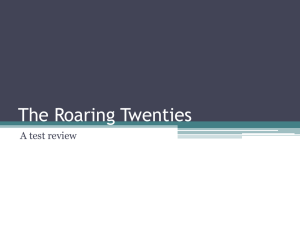US History - Unit 5 - Anaheim Union High School District
advertisement
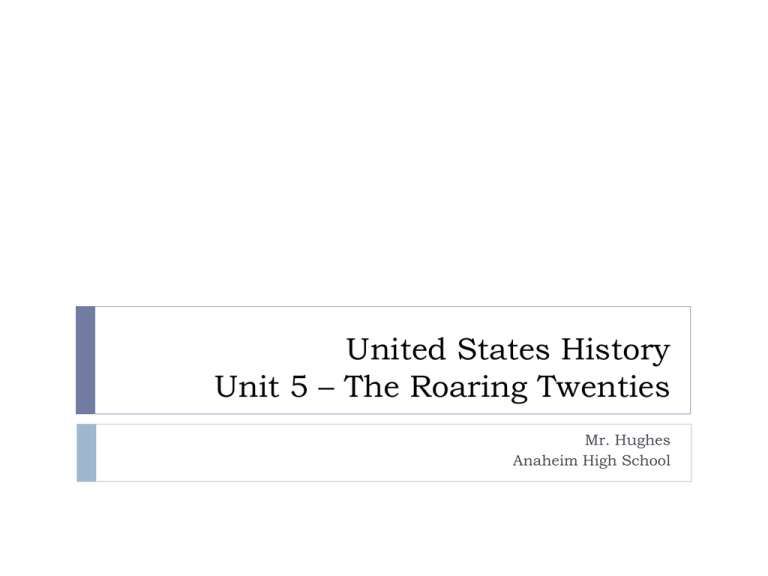
United States History Unit 5 – The Roaring Twenties Mr. Hughes Anaheim High School Postwar Issues In this section, we will look at the American desire for normalcy after WWI and a fear of communism and “foreigners led to postwar isolationism.” Postwar Trends World War I left the American public exhausted. The League of Nations further divided Americans. Soldiers were returning to unemployment or forced others out of a job. The economy slowed due to diminished orders after the war. Two major trends engulfed the American people. Nativism: the prejudice against foreign-born people. Isolationism: a policy of pulling away from world affairs. Fear of Communism One perceived threat to American life was the threat of Communism. Communism was symbolized by their red flag and cried out for the end of capitalism everywhere. A Communist party was formed in the United States. The panic began in 1919 after revolutionaries overthrew the Czarist regime in Russia. It had a group of 70,000 people, many of whom came from the Industrial Workers of the World (IWW) When bombs were being mailed to government leaders the public became fearful. US Attorney General A. Mitchell Palmer took action against this “Red Scare”. Palmer Raids In 1919, Palmer hunted down suspected communists, socialists, and anarchists. They trampled people’s civil rights in the process. Hundreds of foreign born radicals were deported without trials. His raids failed to produce anything and the public began to turn against Palmer. Test Question 1 United States Attorney General A. Mitchell Palmer was controversial because he? a) Criticized democracy and the capitalistic nature of the U.S. b) Secured people’s civil rights. c) Assassinated Sacco and Vanzetti. d) Trampled on the Bill of Rights hunting down suspected communists and anarchists. d) Trampled on the Bill of Rights hunting down suspected communists and anarchists. The Trial of Sacco & Vanzetti In May 1920, Nicola Sacco and Bartolomeo Vanzetti were charged with the robbery and murder of a factory paymaster. They provided alibis, the evidence was circumstantial, and the judge made racial remarks. Witnesses had said the criminals appeared to be Italians. The jury still found them guilty and sentenced them to death. Protests rang out against the court decision. They were executed on August 23, 1927. In 1961, ballistic tests proved the gun used against the guard did belong to Sacco. They however had no proof that he pulled the trigger. Test Question 2 The significance of the Nicola Sacco and Bartolomeo Vanzetti trial was that? a) They were not convicted of robbery or murder. b) Their ethnicity and immigrant status played an important role in their conviction. c) The jury received bribes. d) They became the first immigrants to be convicted of treason. b) Their ethnicity and immigrant status played an important role in their conviction. Limiting Immigration During the Nativist movement, the prevailing attitude was “Keep America for Americans.” Problems in the economy after WWI fueled these opinions. There were 2 major occurrences during this time that helped shape America. The Ku Klux Klan As a result of the “Red Scare” and increase in anti-immigrant feelings, the Klu Klux Klan rose again. By 1924, they had a membership of 4.5 million. There goal was to keep African-Americans “in their place” and to drive Roman Catholics, Jews, and foreign-born people out of the country. Test Question 3 The KKK in the 1920’s opposed all of the following except? a) Nativists. b) African Americans. c) Jews. d) Roman Catholics. a) Nativists The Quota System From 1919 to 1921, the number of immigrants jumped 600 percent. From 141,000 in 1919 to 805,000 in 1921. In response to Nativist pressure, Congress passed the Emergency Quota Act of 1921. They purposely limited immigrants from southern and eastern Europe. They limited to number of people admitted to 2 percent of the people in the U.S. in 1890. This discriminated against Roman Catholics and Jews. Japan was also very upset of the new law. It did not put a limit on immigrants from countries in the Western Hemisphere As a result, 1 million Canadians and 500,000 Mexicans crossed the nations borders. Test Question 4 The Emergency Quota Act passed by Congress in 1921 mainly tried to limit immigration from? a) Western Europe. b) Southern and Eastern Europe. c) Asia and the Middle East. d) Latin America. b) Southern and Eastern Europe Women’s Suffrage As men were off to fight in WWI, women moved into their jobs left behind. This helped the push for Women’s Suffrage. In 1919, Congress passed the 19th Amendment, granting women the right to vote. In 1920, the amendment was ratified by the states. Test Question 5 What effect did the World War I have on the Women’s Suffragist movement? a) It led to the ratification of the Nineteenth Amendment. b) It had little effect. c) It caused a split within the NAWSA. d) It delayed action as attention turned to the war effort. a) It led to the ratification of the Nineteenth Amendment. The Teapot Dome Scandal One of the most spectacular forms of corruption in the US government. The oil reserves were moved from the Navy to the Interior Department. The government had set aside oilrich public lands at Teapot Dome, WY And Elk Hills, CA. Secretary of the Interior, Albert B. Fall suddenly received $400,000 in “loans, bonds, and cash.” Fall was later found guilty of bribery and was the first American to be convicted of a felony while holding a cabinet post. The Presidency of Warren G. Harding Test Question 6 The Teapot Dome Scandal was an example of? a) The failure of the gold standard. b) Kickbacks to favored railroad magnets. c) Corruption within President Harding’s cabinet. d) Corporate greed. c) Corruption within President Harding’s cabinet. The Business of America This section will document how consumer goods fueled the business boom of the 1920’s as America’s standard of living soared. American Industries Flourish President Calvin Coolidge fit right into the business beliefs of the 1920’s He believed the government should stay out of business. His predecessor, Herbert Hoover, also shared this belief. This would allow for the business to flourish and Americans to profit. They kept tariffs on foreign goods high which further helped American manufacturers. At the same time, wages were rising due to new technology. That resulted in higher productivity as well. The Impact of the Automobile The automobile industry changed the American landscape. The biggest impact was the creation of paved roads. The popularity of the automobile brought many other things into the American landscape. This allowed for travel in all types of weather conditions. Gas stations, repair shops, public garages, motels, tourist camps, and shopping centers all came to be because of the car. The automobile also liberated the rural family. They could travel to the city for shopping and entertainment. http://player.discoveryeducation.com/index.cfm?guidAssetId=6 90B6D28-497C-4B64-BF39F4154314F56D&blnFromSearch=1&productcode=US Test Question 1 The popularity of the automobile led to? a) A decrease in the number of jobs in American society. b) The transition of paved roads to dirt roads. c) Travel by train becoming more popular. d) The liberation of the isolated rural family. d) The liberation of the isolated rural family. Test Question 2 Mass production techniques were used most successfully in the early 1900’s in? a) The mining industry. b) The automobile industry. c) The steel industry. d) The airplane industry. b) The automobile industry. Standard Of Living Soars The 1920’s were a prosperous time for the United States. Americans owned about 40 percent of the world’s wealth. This changed the way Americans lived. Gasoline powered much of the boom of the 20’s. Electricity is what really changed the nation. Families could now have refrigerators, cooking ranges, and toasters in their houses. It made the lives of housewives easier and allowed time for more activities outside the home. Dawn of Modern Advertising With an influx of goods on the market, advertising now focused on luring people to their product. Companies went so far as to hire psychologists to study how to appeal to people’s desires. Brand name goods now were becoming familiar from coast to coast. Luxury items were now considered necessities. Test Question 3 The dawn of modern advertising in the 1920’s occurred because? a) Printing paper was cheaper. b) People had less money to spend. c) Of the invention of the airplane. d) Of an influx of new consumer goods flooded the market. d) Of an influx of new consumer goods flooded the market. A Superficial Prosperity Many believed that prosperity would go on forever in the 1920’s. As the number of businesses grew, so did the income gap between workers and managers. Industries like iron, railroads, and farming were not very prosperous during this time. The national income had grown from $64 billion in 1921 to $87 billion in 1929. Farms overproduced goods causing food prices to go down. A new form of buying goods, installment plans or credit, were introduced to further encourage people to buy goods. This was extending people beyond their economic means. http://www.history.com/videos/1929-stock-market-crash#1929-stock-market-crash Test Question 4 During the 1920’s most of the nation’s wealth was in the hands of? a) A few large corporations. b) Farmers and workers. c) Labor unions. d) Small business. a) A few large corporations. Changing Landscape With new opportunities many African Americans left farms in the south for cities in the north. Reasons for the Great Migration. This was known as the Great Migration. It started toward the end of the 1800’s but turned into a tidal wave in the early 1900’s. Escaping racial discrimination. Poor farming conditions. More job opportunities. Racial prejudice did also exist in the north. The movement of African Americans did intensify the tension in northern cities. Test Question 5 The Great Migration of 1910 to 1920 was? a) The march of penguins in the South Pole to the North Pole. b) When thousands of immigrants arrived in California from Mexico and Asia. c) The movement of African-Americans from northern cities to southern cities. d) The movement of African-Americans from the south to northern cities. d) The movement of African-Americans from the south to northern cities. The Roaring 20’s This section will address the new lifestyles, new jobs, and different roles in society during the 1920’s. Changing Ways of Life During the 1920s, urbanization continued to accelerate For the first time, more Americans lived in cities than in rural areas New York City was home to over 5 million people in 1920 Chicago million had nearly 3 Urban vs. Rural Throughout the 1920s, Americans found themselves caught between urban and rural cultures Urban life was considered a world of anonymous crowds, strangers, moneymakers, and pleasure seekers Rural life was considered to be safe, with close personal ties, hard work and morals Prohibition One example of the clash between city & farm was the passage of the 18th Amendment in 1920 This Amendment launched the era known as Prohibition The Volstead Act made it illegal to make, sell or transport liquor Support for Prohibition Reformers had long believed alcohol led to crime, child & wife abuse, and accidents Supporters were largely from the rural south and west The church affiliated AntiSaloon League and the Women’s Christian Temperance Union helped push the 18th Amendment through Test Question 1 The Eighteenth Amendment? a) Overturned Plessy v. Ferguson. b) Excluded women from saloons. c) Gave women the right to vote. d) Banned the manufacture, sale, and transportation of alcoholic beverages. d) Banned the manufacture, sale, and transportation of alcoholic beverages. Test Question 2 The main reason the Volstead Act was unsuccessful was because? a) Organized crime controlled most major police forces b) The Canadian government refused to arrest smugglers at the U.S. – Canadian borders. c) President Harding came out publicly against it. d) The government agency in charge of enforcing the act was underfunded and did not have enough men. d) The government agency in charge of enforcing the act was underfunded and did not have enough men. Speakeasies and Bootleggers Many Americans did not believe drinking was a sin Most immigrant groups were not willing to give up drinking To obtain liquor illegally, drinkers went underground to hidden saloons known as speakeasies People also bought liquor from bootleggers who smuggled it in from Canada, Cuba and the West Indies Organized Crime Prohibition contributed to the growth of organized crime in every major city Chicago became notorious as the home of Al Capone – a famous bootlegger Capone took control of the Chicago liquor business by killing off his competition Test Question 3 Al Capone became notorious mainly because he? a) Lived in New York and drank whiskey. b) Believed alcohol led to crime and teacher abuse. c) Made speakeasies illegal. d) Made millions bootlegging whiskey into Chicago from Canada. d) Made millions bootlegging whiskey into Chicago from Canada. Government Fails To Control Liquor Eventually, Prohibition’s fate was sealed by the government, which failed to budget enough money to enforce the law The task of enforcing Prohibition fell to 1,500 poorly paid federal agents. Clearly an impossible task Support Fades, Prohibition Repealed By the mid-1920s, only 19% of Americans supported Prohibition Many felt Prohibition caused more problems than it solved The 21st Amendment finally repealed Prohibition in 1933 Test Question 4 All of the following were effects of Prohibition EXCEPT? a) Disrespect for the law increased ( smuggling & bootlegging) b) The growth of organized crime. c) Criminals found a source of income. d) Consumption of alcohol dramatically increased. d) Consumption of alcohol dramatically increased. Science and Religion Clash Another battleground during the 1920s was between fundamentalist religious groups and secular thinkers over the truths of science The Protestant movement grounded in the literal interpretation of the bible is known as fundamentalism Fundamentalists found all truth in the bible – including science & evolution Scopes Trial In Scopes was a biology teacher who dared to teach his students that man derived from lower species March 1925, Tennessee passed the nation’s first law that made it a crime to teach evolution The ACLU promised to defend any teacher willing to challenge the law – John Scopes did Scopes Trial The ACLU hired Clarence Darrow, the most famous trial lawyer of the era, to defend Scopes The prosecution countered with William Jennings Bryan, the threetime Democratic presidential nominee Darrow Bryan Scopes Trials Trial opened on July 10,1925 and became a national sensation In an unusual move, Darrow called Bryan to the stand as an expert on the bible – key question: Should the bible be interpreted literally? Under intense questioning, Darrow got Bryan to admit that the bible can be interpreted in different ways Nonetheless, Scopes was found guilty and fined $100 Bryan Darrow Test Question 5 The central issue of the Scopes Trial of 1925 was whether or not? a) Fundamentalism could be taught in schools b) The bible was supreme authority on scientific issues. c) The theory of evolution could be taught. d) Jim Crow laws were illegal. c) The theory of evolution could be taught. The Flapper During the 1920s, a new ideal emerged for some women: the Flapper A Flapper was an emancipated young woman who embraced the new fashions and urban attitudes Test Question 6 An emancipated young woman who embraced new fashions in the 1920’s was known as a? a) Conservatist. b) Fundamentalist. c) Flapper. d) Femi-Nazi. c) Flapper Popular Culture of the 1920’s This section will look at how the mass media, movies, and spectator sports played an important role in creating the popular culture of the 1920’s – a culture that many artists criticized. Education and Popular Culture During the 1920s, developments in education had a powerful impact on the nation Enrollment in high schools quadrupled between 1914 and 1926 Public schools met the challenge of educating millions of immigrants Expanding News Coverage As literacy increased, newspaper circulation rose and masscirculation magazines flourished By the end of the 1920s, ten American magazines -- including Reader’s Digest and Time – boasted circulations of over 2 million Radio Comes of Age Although print media was popular, radio was the most powerful communications medium to emerge in the 1920s News was delivered faster and to a larger audience Americans could hear the voice of the president or listen to the World Series live American Heroes of the ‘20s In 1929, Americans spent $4.5 billion on entertainment (includes sports) People crowded into baseball games to see their heroes Babe Ruth was a larger than life American hero who played for Yankees He hit 60 homers in 1927 http://player.discoveryeducation.com/index.cfm?guidAssetId=2F297D74C409-4317-A258-D8C504D37FDA&blnFromSearch=1&productcode=US Lindbergh’s Flight America’s most beloved hero of the time wasn’t an athlete but a small-town pilot named Charles Lindbergh Lindbergh made the first nonstop solo trans-Atlantic flight He took off from NYC in the Spirit of St. Louis and arrived in Paris 33 hours later to a hero’s welcome http://player.discoveryeducation.com/index.cfm?guidAssetId=B3C3A B10-CE31-4ED6-8276D2FEDA4AE601&blnFromSearch=1&productcode=US Test Question 1 Charles Lindbergh was bet known for? a) Establishing an airline industry in the late 1920’s b) Flying from Paris to San Francisco in record time. c) Deliver transcontinental mail across Europe. d) Being the first to fly nonstop across the Atlantic. d) Being the first to fly nonstop across the Atlantic. Entertainment and Arts Even before sound, movies offered a means of escape through romance and comedy Walt Disney's animated Steamboat Willie marked the debut of Mickey Mouse. It was a seven minute long black and white cartoon. First sound movies: Jazz Singer (1927) First animated with sound: Steamboat Willie (1928) By 1930, millions of Americans went to the movies each week Music and Art Famed composer George Gershwin merged traditional elements with American Jazz Painters like Edward Hopper depicted the loneliness of American life Georgia O’ Keeffe captured the grandeur of New York using intensely colored canvases Gershwin Hopper’s famous “Nighthawks” Radiator Building, Night, New York , 1927 Georgia O'Keeffe Test Question 2 Beginning in the 1920’s, radio and movies encouraged a national popular culture by? a) Making it possible for ordinary people to work fewer hours. b) Allowing poor and rich from across the country share the same entertainment. c) Featuring only upbeat comedies and patriotic themes. d) Portraying only characters from poor backgrounds. Writers of the 1920’s The 1920s was one of the greatest literary eras in American history Sinclair Lewis, the first American to win the Nobel Prize in literature, wrote the novel, Babbitt In Babbitt the main character ridicules American conformity and materialism Writers of the 1920’s Writer F. Scott Fitzgerald coined the phrase “Jazz Age” to describe the 1920s Fitzgerald wrote Paradise Lost and The Great Gatsby The Great Gatsby reflected the emptiness of New York elite society Writers of the 1920’s Edith Wharton’s Age of Innocence dramatized the clash between traditional and modern values Willa Cather celebrated the simple, dignified lives of immigrant farmers in Nebraska in My Antonia Writers of the 1920’s Ernest Hemingway, wounded in World War I, became one of the best-known authors of the era Hemingway - 1929 In his novels, The Sun Also Rises and A Farewell to Arms, he criticized the glorification of war His simple, straightforward style of writing set the literary standard The Lost Generation Some writers were so soured by American culture that they chose to settle in Europe Hemingway and John Dos Passos are examples. In Paris they formed a group that one writer called, “The Lost Generation” John Dos Passos self – portrait. He was a good amateur painter. Test Question 3 __________________ wrote books such as The Sun Also Rises that criticized the war. a) F. Scott Fitzgerald b) Ernest Hemingway c) Georgia O’Keefe d) George Gershwin b) Ernest Hemingway Test Question 4 Which of the following attitudes would be attributed to the writers of the Lost Generation? a) Beliefs in atheism and disillusionment of communal society. b) Support for laissez-faire and capitalism. c) A spirit of patriotism. d) Ridiculing Americans for their greed and materialism. d) Ridiculing Americans for their greed and materialism. The Harlem Renaissance This section will document the growth of African–American ideas, art, politics, literature and music that flourished in Harlem and elsewhere in the United States. THE HARLEM RENAISSANCE Migration of the Negro by Jacob Lawrence Between 1910 and 1920, the Great Migration saw hundreds of thousands of African Americans move north to big cities By 1920 over 5 million of the nation’s 12 million blacks (over 40%) lived in cities http://player.discoveryeducation.com/index.cfm?guidAssetId=AA10ADEA753F-4ABB-8187-14A623266265&blnFromSearch=1&productcode=US AFRICAN AMERICAN GOALS Founded in 1909, the NAACP urged African Americans to protest racial violence W.E.B Dubois, a founding member, led a march of 10,000 black men in NY to protest violence Test Question 1 The Harlem Renaissance refers to? a) a struggle for civil rights led by the NAACP. b) a population increase in Harlem in the 1920s. c) a program to promote African-American owned businesses . d) a literary and artistic movement among AfricanAmericans centered in Harlem, NY. d)A literary and artistic movement among AfricanAmericans centered in Harlem, NY. Test Question 2 The NAACP did all of the following EXCEPT? a) fight for legislation to protect Africans-Americans. b) work with anti-lynching organizations. c) propose that African-Americans move back to Africa. d) become politically active. c) Propose that African-Americans move back to Africa. MARCUS GARVEY - UNIA Garvey represented a more radical approach Marcus Garvey believed that African Americans should build a separate society (Africa) In 1914, Garvey founded the Universal Negro Improvement Association Garvey claimed a million members by the mid-1920s He left a powerful legacy of black pride, economic independence and PanAfricanism HARLEM, NEW YORK Harlem, NY became the largest black urban community Harlem suffered from overcrowding, unemployment and poverty However, in the 1920s it was home to a literary and artistic revival known as the Harlem Renaissance AFRICAN AMERICAN WRITERS The Harlem Renaissance was primarily a literary Mckay movement Led by well-educated blacks with a new sense of pride in the African-American experience Claude McKay’s poems expressed the pain of life in the ghetto LANGSTON HUGHES Missouri-born Langston Hughes was the movement’s best known poet Many of his poems described the difficult lives of working-class blacks Some of his poems were put to music, especially jazz and blues Test Question 3 Langston Hughes wrote about the struggle of ? a) immigrants coming to America. b) African American working class citizens. c) slavery and Jim Crow laws. d) women in a sexist America. b) African American working class citizens ZORA NEALE HURSTON Zora Neale Hurston wrote novels, short stories and poems She often wrote about the lives of poor, unschooled Southern blacks She focused on the culture of the people– their folkways and values http://player.discoveryeducation.com/index.cfm?guidAssetId=D1F10809-C5CE41FE-B7F7-6F45C97F098E&blnFromSearch=1&productcode=US AFRICAN-AMERICAN PERFORMERS During the 1920s, black performers won large followings Paul Robeson, son of a slave, became a major dramatic actor His performance in Othello was widely praised LOUIS ARMSTRONG Jazz was born in the early 20th century In 1922, a young trumpet player named Louis Armstrong joined the Creole Jazz Band Later he joined Fletcher Henderson’s band in NYC Armstrong is considered the most important and influential musician in the history of jazz EDWARD KENNEDY “DUKE” ELLINGTON In the late 1920s, Duke Ellington, a jazz pianist and composer, led his ten-piece orchestra at the famous Cotton Club Ellington was renown as one of America’s greatest composers BESSIE SMITH Bessie Smith, blues singer, was perhaps the most outstanding vocalist of the decade She achieved enormous popularity and by 1927 she became the highestpaid black artist in the world http://player.discoveryeducation.com/index.cfm?guidAssetId=8ad833c0-ac97-4a72 ab80-8d1bf8b41519&blnFromSearch=1&productcode=HUB Test Question 4 An African-American renaissance flowered in New York during the 1920s because of? a) campaigns for equality in the North and racial discrimination in the South. b) pride in the African-American experience as expressed by artists and writers centered in Harlem. c) the strict adherence to old traditions in America. d) popularity of baseball teams such as the Yankees, Giants and Dodgers. b) pride in the African-American experience as expressed by artists and writers centered in Harlem. Test Question 5 African Americans that flourished in the jazz revolution included all of the following EXCEPT? a) Cab Calloway. b) Louis Armstrong. c) Duke Ellington. d) Marcus Garvey. d) Marcus Garvey
